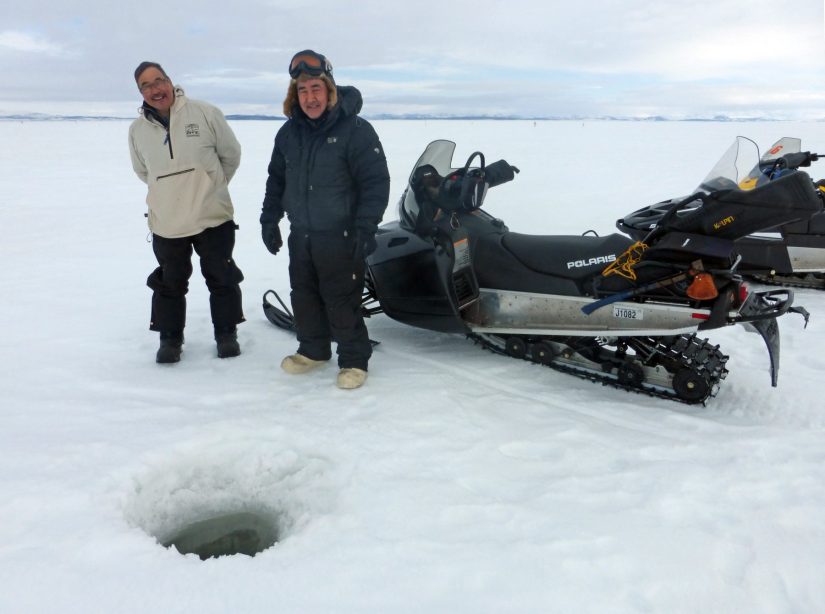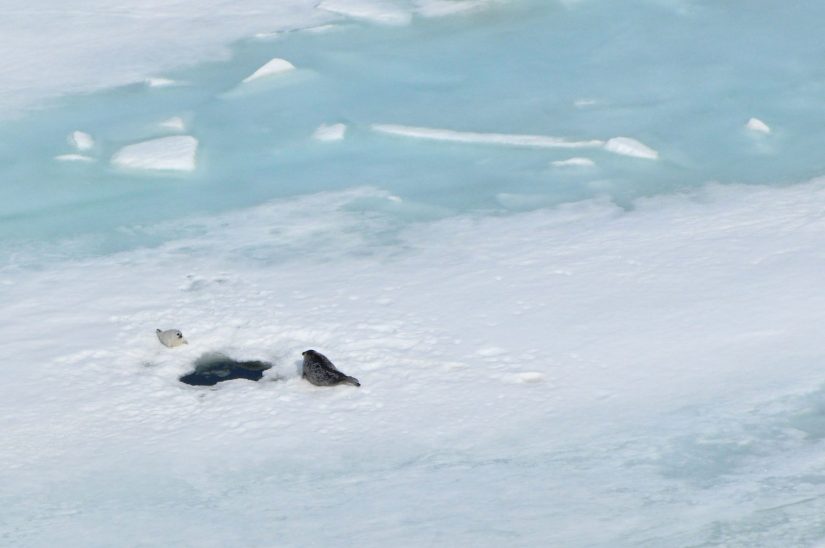On the ice and from the air: Combining Indigenous Knowledge and multidisciplinary science to investigate Alaska’s ringed seals
In the Arctic, where temperatures are rising at nearly four times the global average, a collaborative effort, combining Indigenous Knowledge with multidisciplinary science has been used to investigate the denning habitat selection of Alaska’s ringed seals.
During the Ikaaġvik Sikukun (Iñupiaq for “Ice Bridges”) project, researchers from the University of Washington School of Aquatic and Fishery Sciences (SAFS), Lamont-Doherty Earth Observatory of Columbia University, University of Alaska Fairbanks, the Native Village of Kotzebue, NOAA, and Farthest North Films collaborated with an Elder Advisory Council of Iñupiaq Qikiqtaġruŋmiut Elders with extensive personal history of subsistence hunting and experience on sea ice. The scientists and Elders worked together to identify the research topic and then continued to collaborate throughout the project on the study design and interpretation and dissemination of results.
Essential to Arctic ecosystems, sea ice and snow play a critical role for both marine mammals and Indigenous Peoples in these regions. During an unusually warm spring in 2019, Jessica Lindsay, a SAFS PhD candidate advised by Professor Kristin Laidre, worked with the Ikaaġvik Sikukun team in Kotzebue Sound, Alaska, to investigate how warming temperatures impact where ringed seals (“natchiq” in Iñupiaq) make their dens.
Ringed seals are a valued nutritional, spiritual, and cultural resource for coastal Indigenous communities in the Arctic. A key component of this study, published in the journal Marine Ecology Progress Series in February 2023, was knowledge co-production, which is a research approach that integrates scientific and Indigenous ways of knowing to produce novel insights.

Ringed seals in Alaska are found in the seasonal sea-ice zones of the Bering, Chukchi, and Beaufort seas. They are uniquely adapted to occupy areas of landfast ice by maintaining breathing holes in the ice. As the snow accumulates, these breathing holes are converted to snow-covered dens for resting and birthing in the spring. Climate change is impacting ringed seal habitat in a number of ways, including decreasing spring snow cover for dens.
In the winter of 2018–2019, much less sea ice formed in Kotzebue Sound compared to previous years, giving seals less space for resting and denning.
Bobby Schaeffer, a Kotzebue Elder and co-author of the study, said, “For the first time in Iñupiat history, 90% of Kotzebue Sound was ice-free the entire winter. That has never happened before.”
Breakup of the sea ice also happened earlier in the spring while pups may still have been nursing. That April and May, Lindsay worked with Schaeffer and other researchers out on the sea ice to measure ringed seal habitat features, such as snow depth and surface roughness, which helps snow drifts to form. The research team used drones, or “unoccupied aerial vehicles,” outfitted with cameras to collect images of the sea ice near Kotzebue, which Lindsay then combed through to find seals. Satellite imagery, combined with ground-truthing from on-ice surveys, was used to help describe the snow and ice characteristics at the places where seals were found.

Using the data from both aerial and on-ice surveys, habitat selection models showed that ringed seal groups and pups selected for deeper snow depth and intermediate surface roughness. The habitat conditions in winter 2018–2019 were not typical of previous years in Kotzebue Sound but may be considered indicative of what ringed seal habitat conditions could be like in a future of dwindling ice.
“In a way, the unusual winter in 2019 was a good research opportunity,” Lindsay said. “It gave us the chance to see how ringed seals use the habitat that’s available to them when they don’t have access to a ‘normal’ amount of snow and ice.”

This study came up with a new way to quantify ringed seal habitat by using satellite image characteristics. Brighter areas of the satellite image tended to have deeper snow depth during on-ice surveys, and similarly, areas of the satellite image with high variability in brightness tended to match up with areas on the ice that were rough instead of flat. As sea ice becomes less safe to travel on, remote methods like satellite imagery will become increasingly important for studying seal habitat.
Ringed seals are listed as “threatened” under the US Endangered Species Act, and this study will help wildlife managers better understand what habitat features are important for them as climate change continues to affect Arctic Alaska.

“These types of focal studies are critical to the conservation and management of ice-dependent species. We need to collect data that help us understand the impacts of climate change and we need to work with Indigenous communities while we do it,” says Laidre.
The Ikaaġvik Sikukun project is an important example of how knowledge co-production can ensure that research is successful and that the results are valuable to Indigenous communities who are reliant on marine resources. Insight and involvement from Elders was essential throughout the project.
Cyrus Harris, a Kotzebue Elder and co-author of the study, said, “I see the greatest benefit of Ikaaġvik Sikukun as coming together and really documenting the Indigenous perspective of living on the ice and sea, and looking at how things were back then to today with climate change. It’s been in the minds of Iñupiaq People from time immemorial—this project is just putting the science into it.”
Arctic Indigenous communities such as Kotzebue are on the front lines of climate change, with substantial environmental changes observed even within Elders’ lifetimes, and knowledge co-production studies may become increasingly important for communities and for scientific research in a warming Arctic.

Interested in more information about this project?
- The full study was published on February 9, 2023, as a feature article in the journal Marine Ecology Progress Series (MEPS). It is available to download at https://www.int-res.com/articles/feature/m705p001.pdf.
- Watch the documentary film about the project, produced by Farthest North Films: https://youtu.be/P9RzfGtLWHo.
- Project partners:
- Elder Advisory Council: John Goodwin, Cyrus Harris, Bobby Schaeffer, Roswell Schaeffer Sr.
- Principal Investigators: Christopher Zappa (Lead PI), Lamont-Doherty Earth Observatory, Columbia University; Donna Hauser, International Arctic Research Center, University of Alaska Fairbanks; Andy Mahoney, Geophysical Institute, University of Alaska Fairbanks; Alex Whiting, Native Village of Kotzebue; Sarah Betcher, Farthest North Films; Ajit Subramaniam, Lamont-Doherty Earth Observatory, Columbia University
- Additional team members: Peter Boveng, Marine Mammal Laboratory, Alaska Fisheries Science Center, NOAA-NMFS; Nathan Laxague, Lamont-Doherty Earth Observatory, Columbia University; Carson Witte, Lamont-Doherty Earth Observatory, Columbia University
- Read other papers from the Ikaaġvik Sikukun project:
- Co-production of knowledge reveals loss of Indigenous hunting opportunities in the face of accelerating Arctic climate change
- Thin ice, deep snow and surface flooding in Kotzebue Sound: landfast ice mass balance during two anomalously warm winters and implications for marine mammals and subsistence hunting
- The winter heat budget of sea ice in Kotzebue Sound: Residual ocean heat and the seasonal roles of river outflow
- Read Ikaaġvik Sikukun newsletters here
- All seal research activities were conducted under NMFS MMPA Research Permit No. 19309